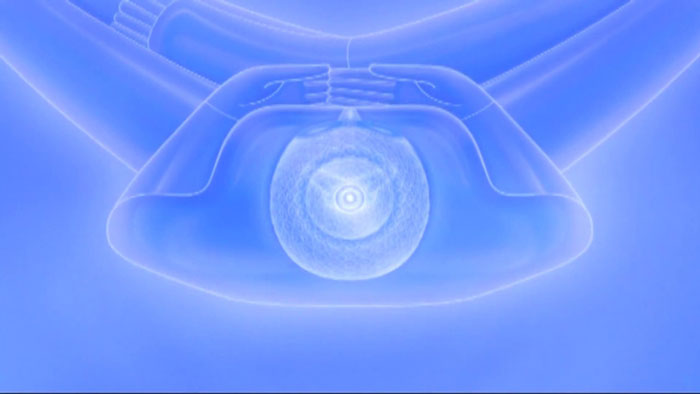
Not long after the Buddha passed away the number of enlightened beings gradually decreased. Those who were able to reach the Dhammakaya level of attainment also dwin-dled. Eventually, the Dhammakaya Knowledge disappeared from the world altogether. Any remnants of information related to Dhammakaya that remained in the Buddhist scriptures were too scant to shed enough light to people of future generations. This led to the general misconception that "Dhammakaya" was nothing more than another name to call the Buddha.
Through a lifetime of meditation study and practice, Luangpu had reached a supramundane level of meditative attainment. This gave rise to his ability to penetrate the "inner" Truth that led to the rediscovery of the Dhammakaya Knowledge. Thereafter, Luangpu dedicated his entire life to perfect this Knowledge, using the "divine eye" of the Dhammakaya as his guide. He compared his meditative experience with various scriptural texts and the Tipitaka to confirm the validity of his discovery. He found that his discovery was consistent with what was mentioned in the Buddhist scriptures.
He explained:
"Dhammakaya is the eternal Buddha, the seed of enlightenment that exists within every human being. It is not something that was newly created. It has been there since the beginning of time. Everyone can attain the Dhammakaya if he or she practices the Right Meditation1 (1Right Meditation (samma-samadhi): Also called "Right Concentration", the eighth element of the Noble Eightfold Path, the practice of which enables one to attain the Dhammakaya). The form of the Dhammakaya resembles that of the Buddha, complete with thirty-two attributes of the Great Man2 (2The Great Man (mahapurușa): A Buddha or a universal monarch (cakravartin king); Buddhas and universal monarchs are traditionally regarded as having the Thirty-two Characteristics of a Great Man). The top of his crown is shaped like a lotus bud. His body is luminous and clear as a crystal."
The name "Dhammakaya" was not invented by Luangpu. This name appeared in the Tipitaka and Buddhist texts of Theravada, Mahayana and Vajrayana traditions.
In the Theravada Buddhist Scripts the word "Dhammakaya" can be found in many places: four times in the primary scriptures, twenty eight times in the secondary scriptures, and seventimes in the tertiary scriptures. The word is found in two places in the Buddhist manual of meditation, the Path of Purity (Visuddhimagga), three times in the commentary on the Path of Purity, once in the ancient version of the Path of Purity, once in the Pathamasambodhigatha, once in the ancient book Samatha-Vipassana, and three times in the Buddhist engravings.
There are four mentions of the word "Dhammakaya" in Agganna Sutta, Dighanikaya; Paccekabuddhapadana, Khuddakanikaya; Atthasandasakatherapadana, Khuddakanikaya; and Mahapachabodigotamitheri, Khuddhakanikaya, in the Thai script of Pali Scriptures of 1982 (Mahamongut edition).
In the Mahayana Buddhist tradition, there are countless mentions of the word "Dhammakaya"-many more times than in the Theravada.
The Dhammakaya method of meditation had been practiced since the ancient times. This method was mentioned in the book Buddharangsi-tissadeeyan ("Buddharangsi-Theory of Jhana3) which spoke about Samatha-Vipassana meditation methods practiced during four historical periods of the past, namely, Vientiane Period of Laos (3Jhana: meditative absorption; bliss state; a state of serene contemplation attained by meditation; state of trance; a state of meditation where the mind is free from the Five Hindrances (craving, aversion, sloth, agitation and doubt), Ayutthaya Period of Siam, Thonburi Period of King Taksin the Great, and Rattanakosin Period of Bangkok.
A manuscript from Wat Pradurongdhamma, Ayutthaya, spoke of a meditation method called "Meditation Through the Virtues of the Buddha, the Dhamma and the Sangha (translation)". This method was recorded in AD 29 by fifty-six Tissapamoke4 masters (4Tissapamoke: a famous academic institution in ancient India). These writings substantiate the fact that Dhammakaya meditation method was not something invented by Luangpu but has been in existence for many centuries.
The Dhammakaya Knowledge disappeared from the world around 43 B.C. For more than twothousand years no one knew of its existence. The Dhammakaya Knowledge rediscovered by Luangpu is the testament to the Enlightenment of the Lord Buddha. Luangpu brought forth to the world the practical side of the knowledge taught by the Buddha.
The meditation method taught by Luangpu had enabled tens of thousands of people to attain Dhammakaya during his lifetime. Many more people continue to attain Dhammakaya to this day.